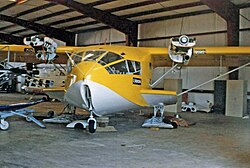| Wilson Global Explorer | |
|---|---|
 The second Global Explorer undergoing maintenance at Santa Fe Airport, New Mexico, in 1995. | |
| General information | |
| Type | amphibian |
| National origin | United States |
| Manufacturer | Dean W. Wilson |
| Designer | Dean W. Wilson |
| Status | Retired |
| Primary user | international explorers |
| Number built | 2 |
| History | |
| Introduction date | 1994 |
| First flight | April 1991 |
The Wilson Global Explorer is an American-built amphibious aircraft of the early 1990s which has been utilised to assist the exploration of remote areas.
